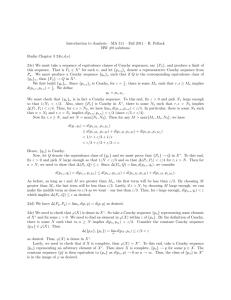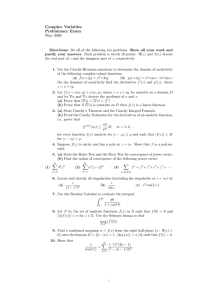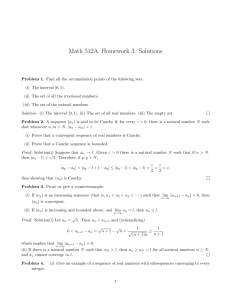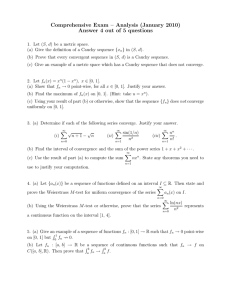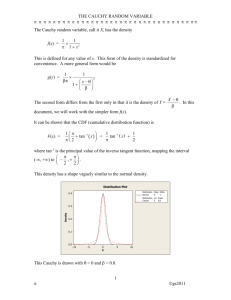Document 10463623
advertisement
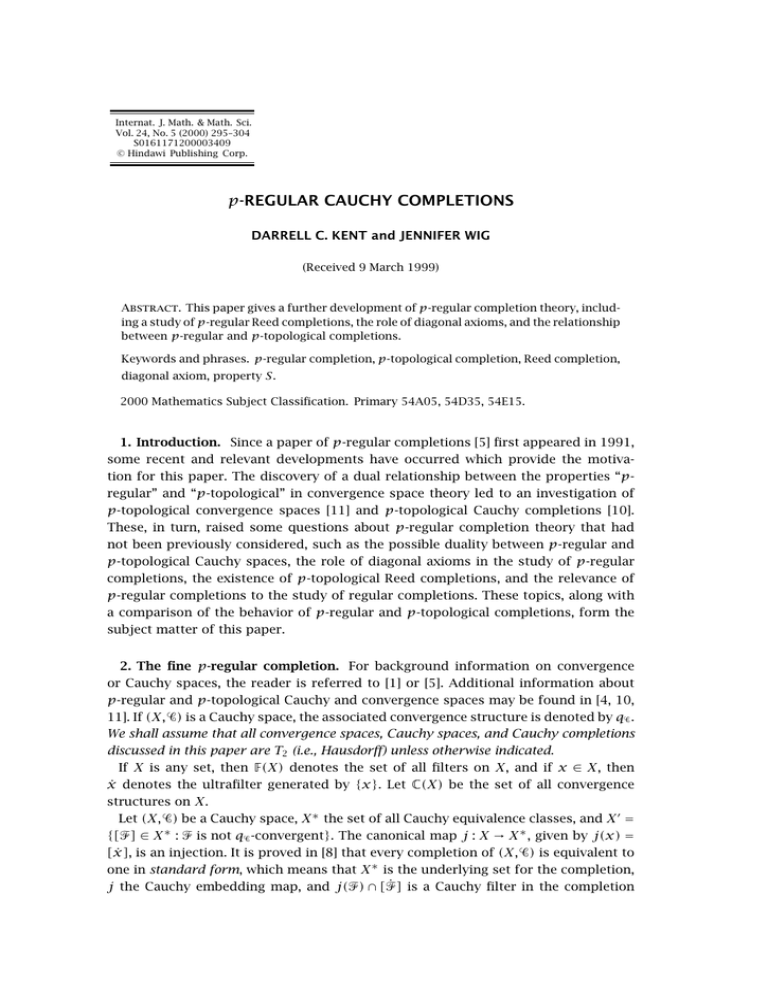
Internat. J. Math. & Math. Sci.
Vol. 24, No. 5 (2000) 295–304
S0161171200003409
© Hindawi Publishing Corp.
p-REGULAR CAUCHY COMPLETIONS
DARRELL C. KENT and JENNIFER WIG
(Received 9 March 1999)
Abstract. This paper gives a further development of p-regular completion theory, including a study of p-regular Reed completions, the role of diagonal axioms, and the relationship
between p-regular and p-topological completions.
Keywords and phrases. p-regular completion, p-topological completion, Reed completion,
diagonal axiom, property S.
2000 Mathematics Subject Classification. Primary 54A05, 54D35, 54E15.
1. Introduction. Since a paper of p-regular completions [5] first appeared in 1991,
some recent and relevant developments have occurred which provide the motivation for this paper. The discovery of a dual relationship between the properties “pregular” and “p-topological” in convergence space theory led to an investigation of
p-topological convergence spaces [11] and p-topological Cauchy completions [10].
These, in turn, raised some questions about p-regular completion theory that had
not been previously considered, such as the possible duality between p-regular and
p-topological Cauchy spaces, the role of diagonal axioms in the study of p-regular
completions, the existence of p-topological Reed completions, and the relevance of
p-regular completions to the study of regular completions. These topics, along with
a comparison of the behavior of p-regular and p-topological completions, form the
subject matter of this paper.
2. The fine p-regular completion. For background information on convergence
or Cauchy spaces, the reader is referred to [1] or [5]. Additional information about
p-regular and p-topological Cauchy and convergence spaces may be found in [4, 10,
11]. If (X, Ꮿ) is a Cauchy space, the associated convergence structure is denoted by qᏯ .
We shall assume that all convergence spaces, Cauchy spaces, and Cauchy completions
discussed in this paper are T2 (i.e., Hausdorff) unless otherwise indicated.
If X is any set, then F(X) denotes the set of all filters on X, and if x ∈ X, then
ẋ denotes the ultrafilter generated by {x}. Let C(X) be the set of all convergence
structures on X.
Let (X, Ꮿ) be a Cauchy space, X ∗ the set of all Cauchy equivalence classes, and X =
{[Ᏺ] ∈ X ∗ : Ᏺ is not qᏯ -convergent}. The canonical map j : X → X ∗ , given by j(x) =
[ẋ], is an injection. It is proved in [8] that every completion of (X, Ꮿ) is equivalent to
one in standard form, which means that X ∗ is the underlying set for the completion,
j the Cauchy embedding map, and j(Ᏺ) ∩ [Ᏺ̇] is a Cauchy filter in the completion
296
D. C. KENT AND J. WIG
structure for every Ᏺ ∈ Ꮿ. Consequently, we shall limit our attention in this paper to
completions in standard form.
If (X, Ꮿ) is a Cauchy space and p ∈ C(X), then (X, Ꮿ) is defined to be p-regular
if Ᏺ ∈ Ꮿ implies clp Ᏺ ∈ Ꮿ, and p-topological if Ᏺ ∈ Ꮿ implies there is Ᏻ ∈ Ꮿ such
that Ᏺ ≥ Ip Ᏻ (where clp and Ip are the closure and interior operators for p). (X, Ꮿ) is
regular (respectively, topological) if it is qᏯ -regular (respectively, qᏯ -topological). The
convergence structure p is extended to a convergence structure p ∗ on X ∗ by defining
p ∗ to be the finest convergence structure on X ∗ satisfying:
p∗
(1) j(Ᏺ) →
[ẋ] in X ∗ if and only if Ᏺ p-converges to x in X;
p∗
(2) if Ᏺ ∈ Ꮿ is non-qᏯ -convergent, j(Ᏺ) →
[Ᏺ] in X ∗ .
A completion of (X, Ꮿ) is p-regular (respectively, p-topological) if the completion
space (X ∗ , Ᏸ) is p ∗ -regular (respectively, p ∗ -topological). Note that a qᏯ -regular (or
qᏯ -topological) completion does not have the same meaning as a regular (or topological) completion.
We next introduce some additional notation and terminology relevant to the study of
p-regular completions. Given a Cauchy space (X, Ꮿ), p ∈ C(X), and A ⊆ X, we define
θᏯ A = {z ∈ X : ∃Ᏻ ∈ z such that A ∈ Ᏻ},
∆p A = j(clp A) ∪ θᏯ A.
If Ᏺ ∈ F(X), ∆p Ᏺ is the filter on X ∗ generated by {∆p F : F ∈ Ᏺ}, and θᏯ Ᏺ is defined
analogously if θᏯ Ᏺ ≠ φ, for all F ∈ Ᏺ.
Lemma 2.1 [5]. If (X, Ꮿ) is a Cauchy space, p ∈ C(X), and A ⊆ X, then:
(a) clp∗ j(A) = ∆p A;
n
n+1
(b) cln
p ∗ j(A) ⊆ ∆p (clp A) ⊆ clp ∗ j(A).
A Cauchy space (X, Ꮿ) is said to have property S if, whenever Ᏺ, Ᏻ ∈ Ꮿ and [Ᏺ] ≠
[Ᏻ], θᏯ Ᏺ ∨ θᏯ Ᏻ fails to exist. Note that θᏯ Ᏺ ∨ θᏯ Ᏻ fails to exist if either of these
filters fails to exist or if both exist but contain mutually disjoint sets. Property S is
a separation property stronger than T2 (since (X, Ꮿ) is additionally assumed to be
T2 ), but weaker than Cauchy separated, which requires the existence of a Cauchycontinuous, real-valued function which separates the non-equivalent Cauchy filters.
∗
Given a Cauchy space (X, Ꮿ) and p ∈ C(X), let Ꮿ∗
p be the Cauchy structure on X gen∗
erated by {∆p Ᏺ : Ᏺ ∈ Ꮿ}. Although Ꮿp is generally not T2 we have the following result.
Proposition 2.2. If (X, Ꮿ) is p-regular, then X ∗ , Ꮿ∗
p is T2 if and only if (X, Ꮿ) has
the property S. If (X, Ꮿ) is p-regular and satisfies S, then X ∗ , Ꮿ∗
p is a completion of
(X, Ꮿ).
Proof. If (X, Ꮿ) satisfies S and [Ᏺ] ≠ [Ᏻ], but [Ᏺ̇]∩[Ᏻ̇] ∈ Ꮿ∗
p , then there are filters
Ᏼ1 , . . . , Ᏼn in Ꮿ such that ∆p Ᏼ1 , . . . , ∆p Ᏼn are linked and [Ᏺ̇] ∩ [Ᏻ̇] ≥ ∩{∆p Ᏼi : i =
1, . . . , n}. From the given assumptions about (X, Ꮿ), we can deduce that ∆p Ᏼ1 , . . . , ∆p Ᏼn
being linked implies that [Ᏼ1 ] = [Ᏼ2 ] = · · · = [Ᏼn ], and so there is Ᏼ ∈ Ꮿ such that
[Ᏺ̇]∩[Ᏻ̇] ≥ ∆p Ᏼ. The latter result implies that [Ᏺ] = [Ᏼ] = [Ᏻ], and this contradiction
shows that X ∗ , Ꮿ∗
p is T2 .
∗
Conversely, assume Ꮿ∗
p is T2 and let Ᏺ, Ᏻ ∈ Ꮿ, so that ∆p Ᏺ and ∆p Ᏻ are in Ꮿp . If
[Ᏺ] ≠ [Ᏻ], then ∆p Ᏺ ∨∆p Ᏻ must fail to exist, and by p-regularity this can happen only
if θᏯ Ᏺ ∨ θᏯ Ᏻ fails to exist. Thus S is satisfied.
p-REGULAR CAUCHY COMPLETIONS
297
To prove the last statement, note that j : (X, Ꮿ) → X ∗ , Ꮿ∗
p is obviously a Cauchycontinuous bijection, and Cauchy-continuity of j −1 follows by Lemma 2.1. Also, j(X)
is obviously dense in X ∗ .
Recall that a completion (X ∗ , Ᏸ) of a Cauchy space (X, Ꮿ) is strict if, for each Ᏼ ∈ Ᏸ,
there is Ᏺ ∈ Ꮿ such that clqᏰ j Ᏺ ≤ Ᏼ.
Proposition 2.3. If (X, Ꮿ) is a p-regular Cauchy space satisfying S, then X ∗ , Ꮿ∗
p
is the finest p-regular completion of (X, Ꮿ). This completion is strict, and is in the fact
the only strict p-regular completion (X, Ꮿ).
Proof. If Ᏺ ∈ Ꮿ, it is clear that ∆p Ᏺ must belong to every p-regular completion of
(X, Ꮿ), which proves the first assertion. The second statement is proved in [5, Propositions 2.6 and 2.7].
In view of Proposition 2.3, we shall call X ∗ , Ꮿ∗
p the fine p-regular completion of a
p-regular Cauchy space (X, Ꮿ) with property S.
Corollary 2.4. The following statements about a Cauchy space (X, Ꮿ) are equivalent:
(1) (X, Ꮿ) is p-regular and satisfies S.
(2) (X, Ꮿ) has a p-regular completion.
(3) (X, Ꮿ) has a strict p-regular completion.
(4) (X ∗ , Ꮿ∗
p ) is p-regular completion of (X, Ꮿ).
Proposition 2.5. If (X, Ꮿ) is a regular Cauchy space which satisfies S, then X ∗ , Ꮿ∗
qᏯ
is the coarsest strict completion of (X, Ꮿ).
Proof. Let (X ∗ , Ᏸ) be any other strict completion. Then Ᏼ ∈ Ᏸ implies there
is Ᏺ ∈ Ꮿ such that Ᏼ ≥ clqᏰ j(Ᏺ) = j(clqᏰ Ᏺ) ∩ θᏯ Ᏺ. The latter filter is in Ꮿ∗
qᏯ , so
Ꮿ∗
≤
Ᏸ
.
qᏯ
3. p-regular Reed completions. In 1971, Reed [9], defined a family of completions
of a Cauchy space (X, Ꮿ), which we shall now describe. By a Reed selection function,
we shall mean a function λ : X ∗ → F(X) which satisfies the following conditions:
(1) λ([ẋ]) = ẋ, for all x ∈ X; (2) if z ∈ X , then λ(z) ≤ Ᏻ, for some Ᏻ ∈ z.
Let Λ be the set of all Reed selection functions on (X, Ꮿ), and for arbitrary λ ∈
Λ, F ⊆ X, and Ᏺ ∈ F(X), let F λ = {z ∈ X ∗ : F ∈ λ(z)}, and let Ᏺλ be the filter on
X ∗ generated by {F λ : F ∈ Ᏺ}. For λ ∈ Λ and Γ ⊆ Λ, the following complete Cauchy
structures are defined on X ∗ : Ꮿλ = {Ꮽ ∈ F(X ∗ ) : ∃z ∈ X ∗ such that Ꮽ ≥ Ᏺλ ∩ ż} and
ᏯΓ = ∩{Ꮿλ : λ ∈ Γ }. Reed showed in [9] that for any Γ ⊆ Λ, (X ∗ , ᏯΓ ) is a completion of
(X, Ꮿ) with an extension property relative to Cauchy-continuous maps into complete,
regular Cauchy spaces. The set X ∗ , ᏯΓ : Γ ⊆ Λ} (including those of the form (X ∗ , Ꮿλ ),
where Γ = {λ}, λ ∈ Λ) is called the Reed family of completions for (X, Ꮿ). By their
construction, it is clear that all Reed completions are strict.
If λ, µ ∈ Λ, λ ≤ µ means λ(z) ≤ µ(z) for all z ∈ X ∗ . Let qλ (respectively, qΓ ) denote
the convergence structure on X ∗ associated with Ꮿλ (respectively, ᏯΓ ).
Proposition 3.1. Let (X, Ꮿ) be a Cauchy space, let λ, µ ∈ Λ with λ ≤ µ, and let
Γ ⊆ ∆ ⊆ Λ. Then
298
D. C. KENT AND J. WIG
(a) Ꮿµ ≤ Ꮿλ and qµ ≤ qλ ;
(b) ᏯΓ ≤ Ꮿ∆ and qΓ ≤ q∆ ;
(c) if γ ∈ Γ and λ ≤ γ for all λ ∈ Γ , then Ꮿγ = ᏯΓ .
Lemma 3.2. If (X, Ꮿ) is a Cauchy space, A ⊆ X, and λ ∈ Λ, then Aλ ⊆ j(A) ∪ θᏯ A.
Proof. If x ∈ X and [ẋ] ∈ Aλ then clearly x ∈ A, and so, [ẋ] ∈ j(A). If z ∈ Aλ ∩X ,
then A ∈ λ(z), and λ(z) ≤ Ᏼ for some Ᏼ ∈ z. Thus A ∈ Ᏼ implies z ∈ θᏯ A.
Proposition 3.3. Let (X, Ꮿ) be a Cauchy space, p ∈ C(X), and ∆ ⊆ Γ ⊆ Λ.
(a) Ꮿ∗
p ≤ ᏯΓ .
(b) (X ∗ , ᏯΓ ) is a p-regular completion of (X, Ꮿ) if and only if Ꮿ∗
p = ᏯΓ .
∗
∗
(c) If (X , ᏯΓ ) is a p-regular completion of (X, Ꮿ), so is (X , Ꮿ∆ ).
(d) Let Γ ⊆ Λ have the property that for each λ ∈ Γ , there is γ ∈ Γ such that γ ≤ λ. If
(X ∗ , ᏯΓ ) is a p-regular completion of (X, Ꮿ), so is (X ∗ , ᏯΓ ).
Proof. If Ᏺ ∈ Ꮿ, then ∆p Ᏺ ≤ Ᏺλ ∩[Ᏺ̇] follows by Lemma 3.2, which establishes (a).
The remaining results follow from (a) along with Propositions 2.3 and 3.1.
Certain Reed completions of an arbitrary Cauchy space (X, Ꮿ) deserve special attention. Two selection functions of particular interest are ω, defined by ω(z) = {X}, for
all z ∈ X , and σ , defined by σ (z) = ᏹz = ∩{Ᏺ : Ᏺ ∈ z}, for all z ∈ X . The completion (X ∗ , Ꮿω ) is called Wyler completion, often denoted in the literature by (X ∗ , Ꮿ∗ );
this is the finest completion of (X, Ꮿ). For a p-regular Cauchy space with property
∗
S, X ∗ , Ꮿ∗
p can be described (see [5]) as the “lower p-regular modification” of (X , Ꮿω ).
∗
The Kowalsky completion [6] is (X , ᏯΣ ), where Σ = {λ ∈ Λ : λ(z) ∈ z, for all z ∈ X }.
Between the Kowalsky completion and the Wyler completion lies the, as yet, unnamed
completion (X, Ꮿσ ). In [10], a Cauchy space is defined to be cushioned if ᏹz ∈ z, for
all z ∈ X . For a cushioned Cauchy space, σ ∈ Σ, and by Proposition 3.1(c), ᏯΣ = Ꮿσ .
In 1984, Colebunders [7], studied conditions under which Kowalsky completion and
other Reed completions are regular. We shall apply her approach to the study of pregular Reed completions. Given a Cauchy space (X, Ꮿ), p ∈ C(X), λ ∈ Σ, and F , A ⊆ X,
we proceed to define some relevant notation and terminology.
F <λ A if and only if for all z ∈ X ∗ , A ∈ λ(z) or X\F ∈ λ(z).
F <λ A if and only if F ∈ Ᏼ for some Ᏼ ∈ z implies A ∈ λ(z).
F <λp A if and only if clp F ⊆ A and θᏯ F ⊆ Aλ .
If Ᏺ ∈ F(X), let
rλ Ᏺ = {A ⊆ X : F <λ A, for some F ∈ Ᏺ};
sλ Ᏺ = {A ⊆ X : F <λ A, for some F ∈ Ᏺ};
p
sλ Ᏺ = {A ⊆ X : F <λp A, for some F ∈ Ᏺ}.
(X, Ꮿ) is relatively round if, for all λ ∈ Σ, Ᏺ ∈ Ꮿ implies rλ Ᏺ ∈ Ꮿ. Reed showed in [9]
that for a relatively round space, ᏯΓ = ᏯΣ , for all Γ ⊆ Σ.
Proposition 3.4. Let (X, Ꮿ) be a Cauchy space, p ∈ C(X), λ ∈ Σ, and Ᏺ ∈ F(X),
then
p
(a) sλ Ᏺ ≤ rλ Ᏺ;
p
(b) if p = qᏯ , then sλ Ᏺ = sλ Ᏺ.
p-REGULAR CAUCHY COMPLETIONS
299
Proof of (b). Let F and A be subsets of X; it suffices to show F <λ A if and only
qᏯ
if F <λqᏯ A. Assuming F <λ A and x ∈ clqᏯ F , there is Ᏼ →
x such that F ∈ Ᏼ, which
implies A ∈ λ([ẋ]) = ẋ; thus x ∈ A. If z ∈ θᏯ F , there is Ᏼ ∈ z such that F ∈ Ᏼ, which
implies by assumption that A ∈ λ(z) and hence z ∈ Aλ . Thus F <λqᏯ A. Conversely, let
z ∈ X ∗ be such that there is Ᏼ ∈ z with F ∈ Ᏼ. It remains to show that A ∈ λ(z). If
qᏯ
z = [ẋ] for x ∈ X, Ᏼ →
x and F ∈ Ᏼ implies that x ∈ clqᏯ F ⊆ A, so A ∈ ẋ = λ([ẋ]). If
z ∈ X then F ∈ Ᏼ ∈ z implies z ∈ θᏯ Ᏺ ⊆ Aλ , and hence A ∈ λ(z).
Theorem 3.5. Let (X, Ꮿ) be a p-regular Cauchy space, p ∈ C(X), and λ ∈ Σ.
p
(X ∗ , Ꮿλ ) is p-regular if and only if Ᏺ ∈ Ꮿ implies sλ Ᏺ ∈ Ꮿ.
Proof. Assume (X, Ꮿ) is p-regular. By Proposition 3.3(b), ∆p Ᏺ = j(clp Ᏺ) ∩ θᏯ Ᏺ ∈
Ꮿλ , and so there is Ᏻ ∈ [Ᏺ] such that ∆p Ᏺ ≥ Ᏻλ . Thus for any G ∈ Ᏻ, there is F ∈ Ᏺ
p
p
p
such that ∆p F ⊆ Gλ , which implies F <λ G. Thus G ∈ sλ Ᏺ, and so Ᏻ ≤ sλ Ᏺ, whence
p
s λ Ᏺ ∈ Ꮿ.
Conversely, the assumed condition implies property S, so it remains to show that
p
p
Ꮿλ ≤ Ꮿ ∗
p . If Ᏺ ∈ Ꮿ, then sλ Ᏺ ∈ Ꮿ by assumption. Let A ∈ sλ Ᏺ. Then there is F ∈ Ᏺ such
p
that F <λp A, implying ∆p G ⊆ Aλ . Thus ∆p Ᏺ ≥ (sλ Ᏺ)λ ∈ Ꮿλ , and therefore Ꮿ∗
p ⊆ Ꮿλ .
Proposition 3.6. Let (X, Ꮿ) be a p-regular Cauchy space, Γ ⊆ Σ. Then (X ∗ , ᏯΓ ) is
p-regular if and only if (X ∗ , Ꮿλ ) is p-regular, for all λ ∈ Γ .
∗
Proof. If (X ∗ , ᏯΓ ) is p-regular, then ᏯΓ = Ꮿ∗
p by Proposition 3.3(b), and each (X , Ꮿλ)
∗
is p-regular since Ꮿp ≤ Ꮿλ ≤ ᏯΓ by Proposition 3.3(a). The converse holds because the
supremum of a set of p-regular Cauchy structures is p-regular (see [5]).
Corollary 3.7. If (X, Ꮿ) is a Cauchy space with a p-regular completion, X ∗ , Ꮿ∗
p
p
is a Reed completion if and only if there is λ ∈ Σ such that Ᏺ ∈ Ꮿ implies sλ Ᏺ ∈ Ꮿ.
It was shown in [7] that for a regular Cauchy space (X, Ꮿ) and λ ∈ Λ, X ∗ , Ꮿ∗
λ is a
regular completion if and only if Ᏺ ∈ Ꮿ implies sλ Ᏺ ∈ Ꮿ. Combining this result with
Proposition 3.4 and Theorem 3.5, we obtain the next corollary.
Corollary 3.8. If (X, Ꮿ) is regular Cauchy space and Γ ⊆ Σ, then (X ∗ , ᏯΓ ) is regular if and only if (X ∗ , ᏯΓ ) is qᏯ -regular.
From Propositions 3.4 and 3.6 and Theorem 3.5, we obtain the next result.
Corollary 3.9. If (X, Ꮿ) is a Cauchy space whose Kowalsky completion is p-regular
for any p ∈ C(X), then (X, Ꮿ) is relatively round.
Lemma 3.10. Let (X, Ꮿ) be cushioned and p ∈ C(X). Then for all Ᏺ ∈ F(X), rσ (clp Ᏺ)
p
≤ sσ Ᏺ .
Proof. Recall that σ (z) = ᏹz = ∩z, for all z ∈ X , and, since (X, Ꮿ) is cushioned,
σ ∈ Σ. Let A ∈ rσ (clp Ᏺ). Then there is F ∈ Ᏺ such that, for all z ∈ X ∗ , A ∈ σ (z) or
p
X\ clp F ∈ σ (z). Since clp F <σ A, clp F ⊆ A, and to show that A ∈ sσ Ᏺ, it suffices to
show that θᏯ Ᏺ ⊆ Aσ .
If z ∈ θᏯ F and z ∈ Aσ , then X\ clp F ∈ σ (z) = ᏹz , and so X\F ∈ ᏹz . But z ∈ θᏯ F implies there is Ᏻ ∈ z such that F ∈ Ᏻ ≥ ᏹz , contrary to X\F ∈ ᏹz . Thus θᏯ F ⊆ Aσ .
300
D. C. KENT AND J. WIG
Theorem 3.11. If (X, Ꮿ) is p-regular and cushioned, then (X ∗ , Ꮿσ ) is p-regular if
and only if (X, Ꮿ) is relatively round.
4. Diagonal axioms. A form of “duality” between the properties “regular” and
“topological” in convergence space theory was first observed by Cook and Fischer
[2] in 1967. Both properties have “diagonal” characterizations and if the concluding
implication in the characterizations of either property is reserved, the resulting axiom
characterizes the other property. This dual behaviour is shown in [11] to extend to
the properties “p-regular” and “p-topological” in the convergence space setting. We
begin this section by showing that properties are likewise dual in the setting of Cauchy
spaces.
Let (X, Ꮿ) be a Cauchy space, J an arbitrary set, and let ρ : J → F(X) be a “selection
function.” Then κρ Ᏺ is defined to be the filter ∪ ∩ in F(X). Next, for a Cauchy
F ∈Ᏺ x∈F
space (X, Ꮿ) and p ∈ C(X), we define the following dual axioms.
p
∆p : Let J be any set, ψ : J → X ∗ , and ρ : J → F(X) be such that ρ(y) →
j −1 ψ(y) if
−1
ψ(y) ∈ j(X) and ρ(y) ∈ ψ(y) if ψ(y) ∈ X . If Ᏺ ∈ F(J) is such that j ψᏲ ∈ Ꮿ, then
κρ Ᏺ ∈ Ꮿ.
p
ˆ p : Let J be any set, ψ : J → X ∗ , and ρ : J → F(X) be such that ρ(y) →
∆
j −1 ψ(y) if
ψ(y) ∈ j(X) and ρ(y) ∈ ψ(y) if ψ(y) ∈ X . If Ᏺ ∈ F(J) is such that κρ Ᏺ ∈ Ꮿ, then
j −1 ψᏲ ∈ Ꮿ.
Let U(X) denote the set of all ultrafilters on X.
Theorem 4.1. Let (X, Ꮿ) be a Cauchy space and p ∈ C(X).
ˆ p is satisfied.
(1) (X, Ꮿ) is p-regular if and only if ∆
(2) (X, Ꮿ) is p-topological if and only if ∆p is satisfied.
ˆp.
Proof. (1) Assume (X, Ꮿ) is p-regular, and let J, ρ, and ψ be as specified in ∆
−1
One can verify that for any Ᏺ ∈ F(J), clp (κρ Ᏺ) ≤ j ψᏲ. Thus κρ Ᏺ ∈ Ꮿ implies
ˆ p , and let
clp (κρ Ᏺ) ∈ Ꮿ by p-regularity, and hence j −1 ψᏲ ∈ Ꮿ. Conversely, assume ∆
p
Ᏺ ∈ Ꮿ and J = {(Ᏻ, y) : Ᏻ ∈ U(X), y ∈ X, Ᏻ →
y}. Define ψ : J → X ∗ by ψ(Ᏻ, y) =
j(y) and ρ : J → F(X) by ρ(Ᏻ, y) = Ᏻ; note that these definitions are compatible
ˆ p . If F ∈ Ᏺ, let HF = {(Ᏻ, y) ∈ J : F ∈ Ᏻ} and let Ᏼ be the
with the assumptions of ∆
filter on J generated by {HF : F ∈ Ᏺ}. One easily verifies that Ᏺ ≤ κρ Ᏼ and, for any
ˆ p , j −1 ψᏴ ∈ Ꮿ. But j −1 ψᏴ ≤ clp Ᏺ,
F ∈ Ᏺ, j −1 ψ(HF ) ⊆ clp F . Thus κρ Ᏼ ∈ Ꮿ and by ∆
so clp Ᏺ ∈ Ꮿ and Ꮿ is regular.
(2) Assume (X, Ꮿ) is p-topological, and let J, ψ, ρ, and Ᏺ be as described in ∆p .
Assume j −1 ψᏲ ∈ Ꮿ. Since (X, Ꮿ) is p-topological, there is Ᏻ ∈ Ꮿ such that j −1 ψᏲ ≥
Ip Ᏻ. Let G ∈ Ᏻ and choose F ∈ Ᏺ such that j −1 ψF ⊆ Ip G. One may verify that G ∈ κρ Ᏺ
and hence Ᏻ ≤ κρ Ᏺ. thus κρ Ᏺ ∈ Ꮿ, and ∆p holds. Conversely, assume ∆p , and let Ᏺ ∈ Ꮿ
p
and J = {(Ᏻ, x) : Ᏻ ∈ U(X), Ᏻ →
x}. Let ψ : J → X ∗ be defined by ψ((Ᏻ, x)) = j(x)
and ρ : J → F(X) be defined by ρ(Ᏻ, x) = Ᏻ. Note that ψ maps J onto j(X); thus
Ᏼ = ψ−1 j Ᏺ ∈ F(J). Thus j −1 ψᏴ = Ᏺ ∈ Ꮿ and, by ∆p , κρ Ᏼ ∈ Ꮿ. One may verify that
Ᏺ ≥ Ip (κρ Ᏼ), and thus (X, Ꮿ) is p-topological.
Combining the preceding result with [10, Proposition 1.2 and Corollary 2.8], we
obtain the next corollary.
301
p-REGULAR CAUCHY COMPLETIONS
Corollary 4.2. Let (X, Ꮿ) be a Cauchy space, p ∈ C(X).
(1) (X, Ꮿ) has a p-regular completion if and only if (X, Ꮿ) has property S and satisˆp.
fies ∆
(2) (X, Ꮿ) has a p-topological completion if and only if (X, Ꮿ) is cushioned and satisfies ∆p .
Two additional diagonal axioms of interest are stated below. Let (X, Ꮿ) be a Cauchy
space, p ∈ C(X), and let λ ∈ Λ, where Λ denotes the set of all Reed selection functions.
p
j −1 ψ(y) if
D̂λp : Let J be any set, ψ : J → X ∗ , and ρ : J → F(X) be such that ρ(y) →
ψ(y) ∈ j(X), and ρ(y) ∈ ψ(y) if ψ(y) ∈ X . If Ᏺ ∈ F(J) is such that κρ Ᏺ ∈ Ꮿ, then
there is Ᏻ ∈ Ꮿ such that κρ Ᏺ ≥ Ᏻλ ∩ [Ᏻ̇].
p
Dλp : Let J be any set, ψ : J → X ∗ , and ρ : J → F(X) be such that ρ(y) →
j −1 ψ(y) if
ψ(y) ∈ j(X), and ρ(y) ∈ ψ(y) if ψ(y) ∈ X . If Ᏺ ∈ F(J) is such that κρ Ᏺ ≥ Ᏻλ ∩ [Ᏻ̇]
for some Ᏻ ∈ Ꮿ, then κρ Ᏺ ∈ Ꮿ.
Special cases of these two dual axioms occur elsewhere in the literature. For instance
λ
D̂p is called Dλ in [1] in the special case where p = qᏯ , and it is proved in [1] that the
Reed completion (X ∗ , Ꮿλ ) of (X, Ꮿ) is regular if and only if (X, Ꮿ) satisfies D̂λqᏯ . In [10],
Dλp is called Dp when λ = ω, and it is proved that (X, Ꮿ) has a p-topological completion
if and only if (X, Ꮿ) satisfies Dω
p . It is also shown in [10] that the Wyler completion
(X ∗ , Ꮿω ) is p-topological if and only if (X, Ꮿ) satisfies Dω
p . These results are special
cases of the next theorem, whose proof we shall omit for the sake of brevity.
Theorem 4.3. Let (X, Ꮿ) be a Cauchy space, p ∈ C(X), and λ ∈ Λ.
(1) (X ∗ , Ꮿλ ) is p-regular if and only if D̂λp holds.
(2) (X ∗ , Ꮿλ ) is p-topological if and only if Dλp holds.
We next characterize those Cauchy spaces which allow a completion which is both
p-regular and p-topological.
Theorem 4.4. For a Cauchy space (X, Ꮿ) which is both p-regular and p-topological,
the following statements are equivalent:
(1) (X, Ꮿ) has a completion which is p-regular and p-topological.
(2) (X ∗ , ᏯΣ ) is p-regular and p-topological.
(3) (X, Ꮿ) is cushioned and relatively round.
σ
(4) (X, Ꮿ) satisfies D̂σ
p and Dp .
Proof. Note that (2) and (4) each implies that (X, Ꮿ) is cushioned and hence ᏯΓ =
Ꮿσ , as noted in Section 3. By Theorem 4.3, it follows that (2) and (4) are equivalent.
Equivalence of (2) and (3) follows by Theorem 3.11, and (2) obviously implies (1). It is
shown in [10] that if (X, Ꮿ) has p-topological completions, then (X, Ꮿσ ) is the coarsest
such completion, and by Proposition 3.3(a), (X ∗ , Ꮿσ ) is finer than the finest p-regular
completion. Thus Ꮿσ is the only candidate for a completion which is both p-regular
and p-topological, and since Ꮿσ = ᏯΣ , it follows that (1) implies (2).
The duality revealed in Theorem 4.1 leads to some interesting similarities between
p-regular and p-topological completions, as illustrated by the first two propositions
of the next section, but there are also some important differences. Whereas all p-
302
D. C. KENT AND J. WIG
topological completions are strict, p-regular completions are generally not, although
every Cauchy space which has a p-regular completion also has a strict one, namely
∗ ∗
X , Ꮿp . We should also keep in mind that every p-topological Cauchy space must
satisfy qᏯ ≤ p (see [10]), whereas no such restriction applies to p-regular Cauchy
spaces or completions.
5. Regular versus qᏯ -regular completions. We first note the obvious fact that
a Cauchy space is regular (respectively, topological) if and only if it is qᏯ -regular
(respectively, qᏯ -topological). However this observation does not extend to Cauchy
completions.
Proposition 5.1. Let (X, Ꮿ) be a Cauchy space.
(1) A regular completion of (X, Ꮿ) is also a qᏯ -regular completion, but the converse
is generally false.
(2) A topological completion of (X, Ꮿ) is also qᏯ -topological completion, but the converse is generally false.
Proof. (1) If (X ∗ , Ᏸ) is a regular completion of (X, Ꮿ), then Ᏼ ∈ Ᏸ implies clqᏰ Ᏼ =
clqᏯ∗ Ᏼ ∈ Ᏸ, and clqᏰ j(X) = clqᏯ∗ j(X) = X ∗ , so (X ∗ , Ᏸ) is also a qᏯ -regular completion.
An example is given in [3] of a Cauchy space (X, Ꮿ) with a regular completion but no
strict regular completion. The existence of a regular completion implies that (X ∗ , Ꮿ∗
qᏯ )
is a qᏯ -regular completion which, being strict, cannot be regular.
(2) The first part of the assertion is easily verified, and an example is found in [10]
of a qᏯ -topological completion which is not topological.
However, for Reed completion, we obtain the following result by [10, Theorem 4.7
and Corollary 3.8].
Proposition 5.2. Let (X ∗ , ᏯΓ ) be an arbitrary Reed completion of (X, Ꮿ).
(a) (X ∗ , ᏯΓ ) is a regular completion if and only if it is a qᏯ -regular completion.
(b) (X ∗ , ᏯΓ ) is a topological completion if and only if it is a qᏯ -topological completion.
The next proposition is a restatement of [7, Theorem 3.4(b)]; it is repeated here in
contrast to the corresponding situation for regular completions, as shown in
Example 5.4
Proposition 5.3 [10]. A topological Cauchy space (X, Ꮿ) has a topological completion if and only if it has a qᏯ -topological completion.
In the example that follows, we construct a regular Cauchy space (X, Ꮿ) with prop
∗
∗
erty S, which therefore has X ∗ , Ꮿ∗
qᏯ as a strict, qᏯ -regular completion. Let (X , Ꮿr )
denote the regular modification of the Wyler completion of (X, Ꮿ). We shall show that
(X ∗ , Ꮿ∗
r ) is not T2 , and it follows by [3, Proposition 1.2], that (X, Ꮿ) has no regular
completion (with or without the T2 property). For readers acquainted with the regularity series (see [9]) of a convergence space, it is of interest to note that (X ∗ , Ꮿ∗
qᏯ ) is
the first term of the regularity series of the Wyler completion. In the next example, it
turns out that the T2 property is “lost” in the transition between the first and the
p-REGULAR CAUCHY COMPLETIONS
303
second terms of the regularity series of the Wyler completion, and consequently
(X ∗ , Ꮿ∗
r ) is not T2 .
Example 5.4. Let X be an infinite set. Let {Ak : k ∈ N}, {Bk : k ∈ N}, {Ck : k ∈
N}, and {Dk : k ∈ N} be denumerable collections of pairwise disjoint, denumerable
subsets of X, such that each member of each collection has an empty intersection
with every member of each of the other collections. We first define some subsets
of X:
A=
Ak ,
An =
k∈N
B=
k∈N
n
Ak ,
Fn = A\An ,
(5.1)
Bk ,
Gn = B\Bn .
(5.2)
k=1
Bk ,
Bn =
n
k=1
Assume further that each Ak is partitioned into a denumerable number of denumerable sets {Akj : j ∈ N}, and carry out the same partitions with the corresponding
notation for Bk , Ck , and Dk , for all k ∈ N.
We next define the following filters on X:
Ᏺ is generated by {Fn : n ∈ N};
Ᏻ is generated by {Gn : n ∈ N};
Ꮽkj is generated by {Akj \F : F finite}, for all k, j ∈ N;
Ꮾkj is generated by {Bkj \F : F finite}, for all k, j ∈ N;
Ꮿkj is generated by {Ckj \F : F finite}, for all k, j ∈ N;
Ᏸkj is generated by {Dkj \F : F finite}, for all k, j ∈ N;
Ᏼk is generated by {Ck \Ckj : j ∈ N}, for all k ∈ N;
k is generated by {Dk \Dkj : j ∈ N}, for all k ∈ N.
Let Ꮿ be the Cauchy structure on X generated by: {ẋ : x ∈ X}∪{Ᏺ}∪{Ᏻ}∪{Ꮽkj ∩ Ꮿkj :
k, j ∈ N} ∪ {Ꮾkj ∩ Ᏸkj : k, j ∈ N} ∪ {Ᏼk ∩ k : k ∈ N}. Since qᏯ is obviously discrete,
(X, Ꮿ) is regular. The proof that (X, Ꮿ) satisfies S is tedious and requires examining
a number of cases; we omit these details. From these observations, we conclude that
∗ ∗ X , ᏯqᏯ is a qᏯ -regular completion of (X, Ꮿ).
Let qr∗ be the convergence structure on X ∗ derived from Ꮿ∗
r , the regular modification of Ꮿw . It is clear that [Ᏺ] and [Ᏻ] are distinct elements of X ∗ , but one can
show that clpr∗ j Ᏺ pr∗ -converges to both of these elements, so that (X ∗ , Ꮿ∗
r ) is not
T2 . From the remarks preceding the example, it follows that (X, Ꮿ) has a regular
completion.
The fact that the analogue of Proposition 5.3 for regular Cauchy spaces fails, as
evidenced by Example 5.4, is perhaps related to another problem: that of finding a diagonal axiom which characterizes Cauchy spaces having a regular (or strict, regular)
completion. An effort to solve this problem for strict, regular completion was recently
made by Brock and Richardson, [1], but the diagonal condition that they found has to
be combined with two additional conditions in order to characterize Cauchy spaces
having strict, regular completions. Indeed, this problem remains unsolved even for
p-regular completions, since our results in Corollary 4.2(a), like that of [1], requires
ˆ p in order to characterize Cauchy
combining an additional property along with ∆
spaces allowing p-regular completions.
304
D. C. KENT AND J. WIG
References
[1]
[2]
[3]
[4]
[5]
[6]
[7]
[8]
[9]
[10]
[11]
P. Brock and G. Richardson, Strict regular completions of Cauchy spaces, Proc. Amer.
Math. Soc. 128 (2000), no. 5, 1547–1554. CMP 1 641 653.
C. H. Cook and H. R. Fischer, Regular convergence spaces, Math. Ann. 174 (1967), 1–7.
MR 37#5837. Zbl 152.39603.
D. C. Kent and G. D. Richardson, Cauchy spaces with regular completions, Pacific J. Math.
111 (1984), no. 1, 105–116. MR 85f:54007. Zbl 541.54031.
, p-regular convergence spaces, Math. Nachr. 149 (1990), 215–222. MR 93a:54018.
Zbl 724.54004.
, p-regular completions and compactifications, Math. Nachr. 151 (1991), 263–271.
MR 92e:54022. Zbl 762.54021.
H. J. Kowalsky, Limesräume und Komplettierung, Math. Nachr. 12 (1954), 301–340 (German). MR 17,390b. Zbl 056.41403.
E. Lowen-Colebunders, On the regularity of the Kowalsky completion, Canad. J. Math. 36
(1984), no. 1, 58–70. MR 85i:54027. Zbl 531.54003.
E. E. Reed, Completions of uniform convergence spaces, Math. Ann. 194 (1971), 83–108.
MR 45#1109. Zbl 217.19603.
G. D. Richardson and D. C. Kent, The regularity series of a convergence space, Bull. Austral.
Math. Soc. 13 (1975), no. 1, 21–44. MR 51#13964. Zbl 308.54001.
J. Wig and D. C. Kent, p-topological Cauchy completions, Internat. J. Math. Math. Sci. 22
(1999), no. 3, 497–509. CMP 1 717 170.
S. A. Wilde and D. C. Kent, p-topological and p-regular dual notions in convergence theory,
Internat. J. Math. Math. Sci. 22 (1999), no. 1, 1–12. MR 2000g:54013. Zbl 936.54003.
Darrell C. Kent: Department of Pure and Applied Mathematics, Washington State
University, Pullman, WA 99164-3113, USA
E-mail address: dkent@wsunix.wsu.edu
Jennifer Wig: Department of Pure and Applied Mathematics, Washington State University, Pullman, WA 99164-3113, USA
E-mail address: wig@beta.wsu.edu

